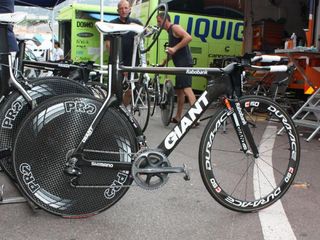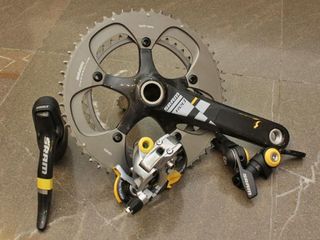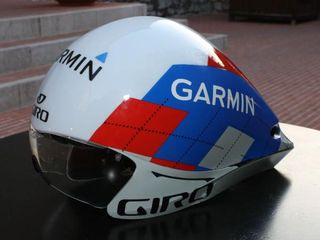Consumer version of Giant's radical TT bike on the way
More time trial tech from Stage 1

































First it was Scott, then Specialized, then Trek, and now Giant.
One of the UCI's latest technical rulings dictates that all race bikes must not only meet the stated dimensional guidelines but now also should be either currently "marketed" or at least "marketable." Interpret that as you will but not surprisingly, team sponsors have made quite sure to officially provide information on their latest and greatest aero rigs in order to provide more evidence of their intent to release publically available versions.
Giant is apparently next to confirm that its radical aero bike will be offered to consumers with an official statement expected before the upcoming team time trial around Montpellier on Tuesday. We'll have more concrete information then but certain technical aspects of the consumer version are already readily discernible.
Team bikes – including that of Rabobank team leader Denis Menchov – have their rear brakes mounted in the conventional position on the back of the seat stays but production models (and a few team bikes) will relocate them to a lower drag position behind and below the bottom bracket. Those frames will also feature integrated mounts on the non-driveside chain stay for a Shimano Dura-Ace Di2 battery plus a neater-looking rubber gasket around the top of the seat tube instead of the 'mechanic's special' strips of electrical tape currently used by the team.

All of the bike's critical aero features will apparently remain intact, including the innovative front-end assembly – which will reported be carbon in production and not aluminum as on some team bikes – the intricate internal cable routing, the integrated made-by-Giant carbon aerobar, and the weight-saving press-fit bottom bracket cups.
Unless the design has further evolved, production bikes will presumably also include front and rear brakes given the unique long-reach scissor-type front caliper and mirror-image rear (the cable arm is on the opposite side of the mounting stud from the normal placement).
Specific information on Giant's pending new time trial offering such as retail pricing, available sizes and model configurations – or an official name – will have to wait until next week but for now, eager consumers can at least rest assured with the confirmation that they'll be able to get one – eventually.
Get The Leadout Newsletter
The latest race content, interviews, features, reviews and expert buying guides, direct to your inbox!
Custom SRAM bits for Astana, Saxo Bank
"Special athletes deserve special treatment." That's how SRAM US road PR manager Michael Zellman put it just prior to the start of this year's Tour de France, where SRAM has provided its Astana and Saxo Bank teams with a few custom finished bits plus complete custom groups for a handful of key riders.
Lance Armstrong and Alberto Contador (Astana) in particular will head out on complete one-off Red packages highlighted with yellow accents for the returning Texan and white graphics for the 2008 Tour de France winner. According to Zellman, the groups are otherwise standard but still required over forty man-hours of work per ensemble – each of which had to be disassembled and repainted by hand in SRAM's Chicago headquarters.

The yellow groups will also be used in the event that a SRAM-sponsored rider finds himself in the maillot jaune - such as Stage 1 winner Fabian Cancellara – and all other Astana and Saxo Bank riders' DoubleTap levers will be fitted with team-only graphics that are easier to spot in a crowd.
SRAM-sponsored riders will also use the company's more aerodynamic smooth-sided outer chainrings for this year's time trials as usual but more aggressive machining on the reverse side shaves about 25g per ring relative to the current consumer version. Actual weight is now a more reasonable 140g or so.
Giro debuts new aero helmet in Monaco
Second-place finisher Alberto Contador, Lance Armstrong (Astana), Denis Menchov (Rabobank), David Zabriskie (Garmin-Slipstream) and others departed the start house in Monaco using a new Giro time trial helmet. According to Giro brand manager Kevin Franks, the as-yet-unnamed helmet has been independently tested at the Kirstin Wind Tunnel to be "considerably faster than any other helmet in zero degree yaw situations, and remarkably faster in 5, 10, and 15 degree yaw situations," – by as much as 60 seconds over 40km depending on conditions.
Franks goes on to say that the new helmet "represents a paradigm shift in aerodynamic helmet technology." How exactly, you might ask?
Giro designed the new helmet to work with the wide range of positions employed by today's time trial riders – from Levi Leipheimer's (Astana) more contemporary 'lotus' position to the more classic pose of David Zabriskie (Garmin-Slipstream) – and the varied head positions used throughout. As such, the lower edge of the helmet is noticeably more tapered than usual to work better when a rider's head is down but still stays aero when tucked against the back.

Further drag reduction comes courtesy of the integrated visor – which is presumably removable depending on rider's eyewear preferences.
Interesting, the new helmet has no forward-facing vents whatsoever. According to Franks, there is however an "intricate series of internal channels that exhaust out the back of the helmet," suggesting that cooling will be more of a passive process than the more active ones currently used.
Stay tuned for more.
Look's new KeO 2 Max pedal makes Grand Tour debut
Five teams in this year's Tour de France (Cofidis, Silence-Lotto, Quick Step, Agritubel, and Astana – save for Lance Armstrong who remains on Shimano and Andreas Klöden who stays on Time) are competing in this year's Tour de France aboard Look's next generation pedal, the KeO 2 Max.
The new pedals feature a larger platform with 12 percent more surface area plus a co-molded stainless steel wear plate for a more stable feel and smoother float. In addition, the pedal spindle diameter grows from 10mm to 12mm for additional stiffness and the mounting threads are also 2mm longer to better accommodate riders who may need to increase their stance width for biomechanical reasons.
A newly pared-down body design helps keep the weight low however. Actual weight for a pair of KeO Composite pedals is 260g without cleats while the KeO Carbon pedals are just slightly lighter at a claimed 244g. Both are fitted with steel spindles but Alberto Contador gets a special lighter set of KeO Carbon pedals with titanium axles.
Conveniently, the new KeO pedals will use the same cleat design as on the existing KeO, which will eventually be wholly replaced by the new body style. Some regions already have the KeO on store shelves but Look anticipates any remaining markets will have them by the end of the month.